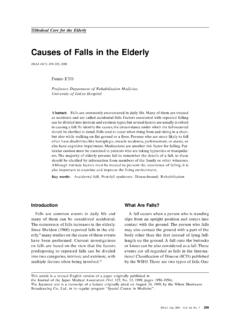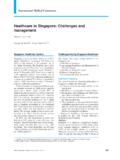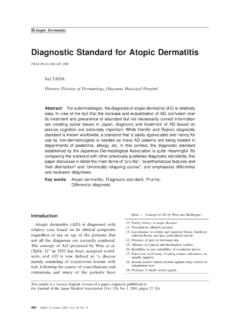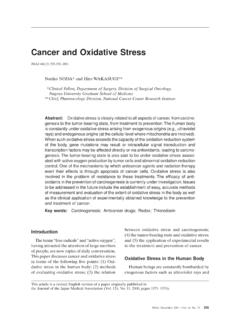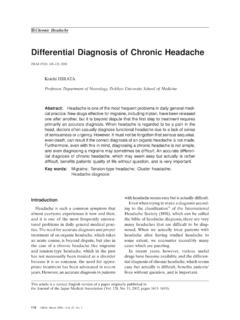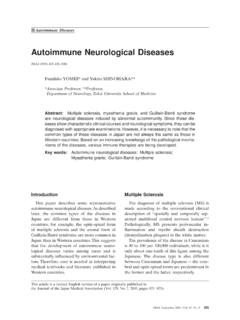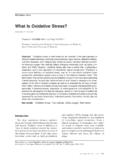Transcription of Indications for Total Knee Arthroplasty and Choice …
1 Feature: Arthroplasty Indications for Total knee Arthroplasty and Choice of prosthesis JMAJ 44(4): 153 158, 2001. Hiroomi TATEISHI. Director, Sasayama Hospital, Hyogo College of Medicine Abstract: Total knee Arthroplasty (TKA) is performed when the knee joint is severely damaged in osteoarthritis, rheumatoid arthritis and other diseases. In Japan, about 20,000 TKA procedures are performed each year and it is the second most common Arthroplasty after Total hip Arthroplasty (THA). knee replacement prostheses can be classified into three categories, which are unconstrained, semiconstrained, and constrained. Depending on the underlying disease and the extent of destruction of the knee joint, a prosthesis is selected. At present, semiconstrained prostheses are most commonly used.
2 This type of prosthesis can be divided into groups depending on whether surgery requires excision of the posterior cruciate ligament and whether the prosthesis has posterior stabilizer or not. A prosthesis that can be implanted while sparing the posterior cruciate liga- ment is most commonly employed. When the knee is severely damaged and unstable, however, a stabilised prosthesis is used. Unconstrained prostheses are used for unicompartmental knee Arthroplasty . Constrained prostheses are used for revision Arthroplasty and for Arthroplasty in knees that are extremely unstable, although the employment of this type is rare. Thus, a prosthesis is chosen depend- ing on the underlying disease and the extent of destruction of the knee along with consideration of the general health and the blood supply to the lower extremity.
3 Key words: knee prosthesis ; Total knee Arthroplasty ; Osteoarthritis;. Rheumatoid arthritis; PCL-sparing Arthroplasty joint damage, and the age of the patient. The Introduction Indications for Total knee Arthroplasty are dis- Total knee Arthroplasty has been most com- cussed in this article based on the underlying monly performed for severe knee joint dam- disease and the extent of knee damage age in patients aged 60 and over. The replace- together with a description of the various ment prosthesis of Choice varies depending on types of prosthesis . the underlying disease, the severity of knee This article is a revised English version of a paper originally published in the Journal of the Japan Medical Association (Vol. 123, No. 4, 2000, pages 470 474).
4 The Japanese text is a transcript of a lecture originally aired on October 26, 1999, by the Nihon Shortwave Broadcasting Co., Ltd., in its regular program Special Course in Medicine . JMAJ, April 2001 Vol. 44, No. 4 153. H. TATEISHI. Table 1 Types of knee Prostheses frequently. In the United States, however, stabilised 1. Unconstrained Modular type-Marmor, Lotus, Savastano polycentric prostheses that require excision of the poste- type (for unicompartmental knee Arthroplasty ) rior cruciate ligament have been used most 2. Semiconstrained commonly, possibly because of the different Many prostheses fall into this category, including the geomedic, anametric, Total condylar, kinematic, health care system from that in Japan. The Kodama-Yamamoto, ceramic devices and others.
5 Constrained type of prosthesis is only indi- (Prostheses implanted with preservation of the pos- terior cruciate ligament, prostheses implanted with cated for knees that are very unstable because excision of the posterior cruciate ligament, and of large bone defects or for revision Total knee stabilised prostheses.). Arthroplasty . A prosthesis of this type consists 3. Constrained Walldius, Shiers, Gu par, Kinematic rotating hinge of a tibial component and a femoral compo- nent, which are connected by a hinge, and it allows reconstruction of a stable knee . Types of knee prosthesis Fixation of knee Prostheses Total knee Arthroplasty is usually per- To fix each component of a prosthetic joint formed in patients aged 60 years or older to the bone, there are two possible methods.
6 When the bone and articular cartilage are so Methyl methacrylate bone cement can be used severely damaged that there is no other effec- as one method, whereas screws are used along tive therapy. The common diseases causing with metal beads or hydroxyapatite granules knee damage treated by Arthroplasty are in uncemented fixation. The beads or granules osteoarthritis, chronic rheumatoid arthritis, are applied to the bone surface under the and osteonecrosis, while contraindications for prosthesis . knee Arthroplasty include purulent arthritis If the patient is relatively young and the and tuberculosis. bone is strong, as occurs in osteoarthritis, knee prostheses can be classified into uncemented fixation is useful. In patients with three major types, which are unconstrained, rheumatoid arthritis or osteoporosis, however, semiconstrained, and constrained.
7 Like an the bone is often fragile and uncemented fixa- endoprosthesis for unicompartmental knee tion frequently results in subsidence or loos- Arthroplasty , an unconstrained device is used ening of the implant. Consequently, cemented to replace only a very small portion of the ar- fixation, which allows early resumption of ticular surface or a very thin surface layer of weight bearing and achieves a better outcome, tissue, leaving the anatomical structure of the is useful for such patients. joint intact. A semiconstrained prosthesis is There is also hybrid fixation, which is a also used for superficial joint replacement. combination of cemented and uncemented There are two types of semiconstrained fixation. In hybrid fixation, either the femoral devices.
8 One requires excision of the posterior or tibial component is fixed with bone cement, cruciate ligament, whereas the ligament is while the other component is fixed without spared by the other type. In Japan, the poste- cement. Usually, uncemented fixation is used rior cruciate-sparing type of semiconstrained for the femoral component, while the tibial prosthesis is most frequently used. Among the component is cemented. prostheses requiring excision of the posterior cruciate ligament, the stabilised prosthesis , Osteoarthritis which facilitates the acquisition of antero- posterior stability of the knee , is used most The most common disease of the knee is 154 JMAJ, April 2001 Vol. 44, No. 4. Total knee Arthroplasty . osteoarthritis. This is initially treated by reha- (BMI: weight (kg)/height (m)2) exceeding 25.
9 Bilitation (exercise), thermotherapy, topical or 27 is considered to indicate mild obesity medications (moist packs), and wearing of a and obesity, respectively. It is desirable for this supporter, while the course is being followed. index to be below 25. The mean BMI. Additional conservative management includes exceeded 25 in 50 patients who underwent using a plate under the sole to raise the lateral Total knee Arthroplasty recently at our depart- border of the foot, and intraarticular injection ment. It cannot be denied that patients tend to of agents such as hyaluronic acid to protect be obese when their osteoarthritis is so ad- the cartilage. Symptoms unresponsive to such vanced that it requires surgical treatment. conservative treatment are an indication for UKA of the knee has several advantages: 1).
10 Surgery. Osteotomy and knee Arthroplasty are It only takes a short time to perform, 2) post- indicated for younger and older patients, operative rehabilitation can be started earlier respectively. and proceeds smoothly, and 3) the surgical In more than 95% of Japanese patients with invasion is smaller and there is little risk of osteoarthritis of the knee , deformity of the postoperative infection. If the patient is over- bone and articular cartilage predominantly weight, the prosthesis will subside over time affects the medial compartment. This type of postoperatively and then will become loose. osteoarthritis is usually treated by high tibial Consequently, the weight should be controlled osteotomy if the patient is relatively young, quite strictly.
